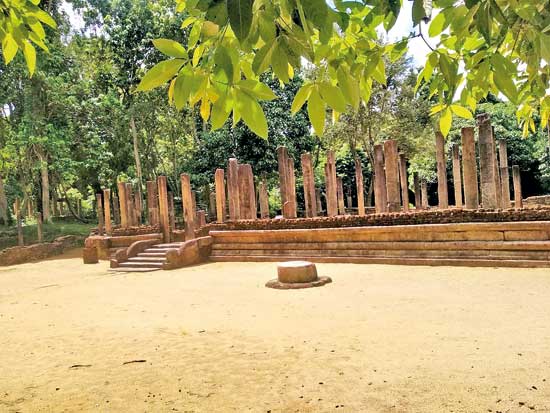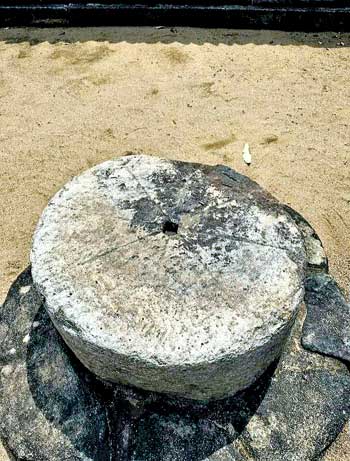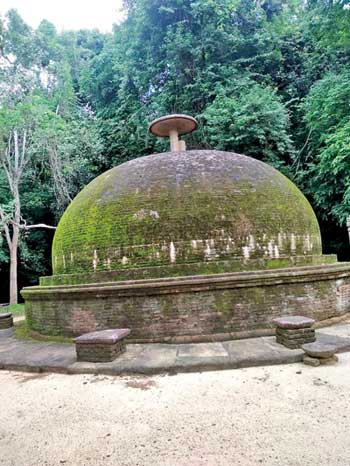Rajagala: So much still shrouded in jungle cover

The giant standing Buddha now lying on the ground. Pix by Pamal Yapa
Rajagala, or Raassagala as it was once known, is a place shrouded in mystery. Though officially discovered in the 1890s, the major part remains unexcavated – this despite the countless stupas already silhouetted against the sky on precipices and the caves with not just drip-ledges but also beautiful stone masonry, water spouts and giant stone bowls.
To reach there, we drove past chenas and paddy fields but mostly jungle, on the Ampara- Maha Oya road, and drew up at the car park where the rilaw with their wily visages and the dark langur were chattering on the trees, eyeing us. The sense of peace with the massive trees and thick jungle cover was soothing, transporting us to the time of the Arahats.
Spread over 1600 acres (some say 1900), this monastery is not second to Mihintale, harbouring even more relics.
The trek takes at least four hours and visitors are advised to take water, and any tidbits that should be well-covered (if you are to evade the simian ‘highwaymen’). There are two paths up the mountain and both somewhat precarious, demand surefootedness.
At each level you will find ruins scattered like fallen flowers and leaves: giant guardstones with strange figures and stranger deities lying upturned, and mounds by the path, covered with thick jungle and pus-wel, speaking of countless relics under the jungle tide, still to be unearthed.
Rajagala harks back to the time of King Saddhatissa (r. 137- 119 BC) younger brother to the great Dutugemunu, when the heir apparent, Lajjitissa, laid the foundation here. It was however, home previously to prehistoric man, who left his crude stone implements in many of the hundreds of caves.

Ruins of a monastic complex
The climb through tortuous pathways leads to many a jaw-dropping sight. Among these is the giant standing Buddha now lying on the floor, somewhat roughly chiselled but exuding a very ancient aura. There are too, innumerable image houses, refectories, monastic buildings, ponds and promenades in hundreds of nooks and crannies.

The ancient sundial
The oldest name recorded in this jungle fastness is Dhana Tisa Pavata, Tisa being a reference to Lajjitissa. It was also called Girikumbhila (‘Crocodile Rock’, due to its shape) and Arittara Vehera.
Elephants cross these paths frequently; their ‘calling cards’ we found scattered about the rocks, though the only creature we actually saw apart from the monkeys was a butterfly with aptly saffron wings.
The most important relic here is probably the stupa built for that revered emissary of Emperor Asoka’s own blood, the Thera Mahinda, an octagenarian when he attained Nirvana here – his adopted land.
It’s a small, wild cairn of a stupa, not as impressive as the edifice most people will identify as being emblematic of Rajagala, the neat and beautiful stupa with stone chathra or parasol instead of traditional spire and pinnacle. This latter brown brick stupa is a stunning facsimile of the famed stupa at Sanchi, and takes one unawares.
Many are the inscriptions scattered in the monastery complex, the most important, one that testifies to Thera Mahinda’s relics lying here, giving credence to the Mahavamsa account.
In her recent book, Ravana’s Lanka, Sunela Jayewardene visited these wild ruins and with her unique vantage point as an environmental architect (and amateur historian), wrote about ‘the standard of excellence that runs like a current through all the structures at Raksagala’. The 2000-year-old sundial she found, the veritable ‘first-class’ spa by the lake, the expert irrigation engineering, the sophisticated and elegant stone masonry of the caves, the lightning arrestor that the chathra of the stupa must have been: all these Sunela ties up with the expertise of the aboriginal Rakusas – a pre-Vijayan people who gave their name to this mountain and may be the ancestors of the present-day Veddahs…
While descending Rajagala, from a different path, we were again struck by the potential of this ancient place still under thick jungle tide; history, one feels, would be rewritten if we knew at least one-tenth of the story of Rajagala…

Small but unique: The stupa with stone chathra or parasol
Searching for an ideal partner? Find your soul mate on Hitad.lk, Sri Lanka's favourite marriage proposals page. With Hitad.lk matrimonial advertisements you have access to thousands of ads from potential suitors who are looking for someone just like you.


